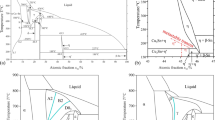Abstract
The production of alloys by means of ingot technology leads to micro-and macrosegregation, separation of phases and impurities, often into large, brittle particles, and coarse grain size. Alloy development is frequently restricted because of the coarseness of the structure and the resultant imposed limitations on hot and cold plasticity. One ready means of avoiding these problems is to produce the alloy in powder or pellet form; this permits attainment of high cooling rates in the liquid and solid, minimizes segregation, alters phase separation and distribution advantageously, and results in significantly finer structures. The powders utilized to produce wrought shapes may be much coarser than press-and-sinter powders, leading to important processing economies without sacrifice of structure refinement. The alloy systems Cu-Zr and Cu-Zr-Cr were selected for the present study; these are high conductivity, high strength alloys of commercial interest. Cooling rates for these specific powders using nitrogen atomization varied from about 103 to 104°CJsec. Powders were cleaned, canned, and hot extruded to produce bar stock; mechanical testing was performed on both as-extruded and thermomechanically-worked samples, with highly beneficial improvements in strength, ductility, and high-temperature structural stability.
Similar content being viewed by others
References
U. M. Martius:Progress in Metal Physics, vol. 5, p. 279, Pergamon Press, London, 1954.
T. F. Bower, H. D. Brody and M. C. Flemings:Trans. TMS-AIME, 1966, vol. 236, p. 624.
H. Matyja, B. C. Giessen, and N. J. Grant:J. Inst. of Metals, 1968, vol. 96, p. 30.
R. Ray: Sc.D. Thesis, Massachusetts Inst. of Technology, Department of Metal-lurgy and Materials Science, Cambridge, Mass., 1969.
W. Hodge:Trans. AIME, 1957, vol. 209, p. 408.
M. J. Saarivirta:Trans. TMS-AIME, 1960, vol. 218, p. 431.
M. J. Saarivirta:Metal Ind., 1963, vol. 103, p. 685.
CL. Bulow:Electro-Technol, 1963, vol. 71, p. 113.
M. J. Saarivirta and P. P. Taubenblat:Trans. TMS-AIME, 1960, vol. 218, p. 935.
Author information
Authors and Affiliations
Additional information
V. K. SARIN, formerly Research Assistant, Department of Metallurgy and Materials Science, Massachusetts Institute of Technology, Cambridge, Mass.
Rights and permissions
About this article
Cite this article
Sarin, V.K., Grant, N.J. Cu-Zr and Cu-Zr-Cr alloys produced from rapidly quenched powders. Metall Trans 3, 875–878 (1972). https://doi.org/10.1007/BF02647661
Received:
Published:
Issue Date:
DOI: https://doi.org/10.1007/BF02647661




